The Cartographers system is fantastic. Simple, compelling, creative; it ticks a lot of boxes. Here at Meeple Mountain we’ve already got reviews of the original Cartographers and sequel Cartographers Heroes (with Map Packs 1-3). But 2022 brought three new Map Packs so we’ve equipped our crayons to brave the unknown and document these new environments for the benefit of our readers. Plus at the end we take a quick look at all the currently available mini-expansions. It’s a tough job but someone’s gotta do it.
Map Pack 4 – Frozen Expanse: Realm of Frost Giants
Frozen Expanse introduces three small changes to the standard game: 1) ‘scouted’ squares on the map indicate which terrain type must be placed there; 2) a frozen lake provides a bounty of coins if surrounded; 3) two new ambush cards and one new hero card join the battle.
The scouted spaces (in setting-speak, fragments of known landscape from a previous expedition) restrict the central puzzle in a way that often makes seasonal scoring harder. Most of the time they’re great, adding a satisfying challenge. Occasionally they accentuate those moments when the draw of the explore cards edges the game into more frustrating territory, since scouted spaces can get in the way. Often in both the base games there’s only so much you can do when the explore cards don’t go your way. Normally that’s just part of the game but here infrequent and mild frustration can tip into genuine annoyance.
Scoring additional points for filling scouted spaces also adds a push-pull, broadening the decision space… if you can see which scouted spaces you’ve drawn over (which, from a production standpoint, could be a lot clearer).

Surprisingly, the frozen lake is the most interesting aspect of this map pack, acting like a much larger and bountiful mountain. It’s an additional tug on your attention that provides a worthwhile reward if tackled early.
The new hero is one powerful penguin with its attack pattern (particularly if lined up just so with the Flayer Incursion ambush) and it’s also great to have more ambush cards that do something in the Heroes mode rather than the vanilla villains of the original game. Whilst all three cards talk about scouted spaces, they also work well enough when you aren’t playing with the Frozen Expanse map, making this the only map pack to contribute to the wider game environment. Bonus!
All in all, Frozen Expanse is a (frozen) solid addition, challenging if occasionally frustrating with the shuffle and unclear scouted spaces.
Map Pack 5 – Kethra’s Steppe: Redtooth & Goldbelly
A fifth scoring card type is the headline attraction of Kethra’s Steppe, tied to each map’s two mountain-based beacons and their surrounding ranges. Beacons are like mountains and are lit when surrounded. Once lit their scoring card comes into play, providing you with positive and negative points for how you’ve filled the ranges or rows/columns surrounding each beacon.
Rather like the subtle impact of the lake in Frozen Expanse, the true star of Kethra’s Steppe isn’t the beacons or playing with a fifth scoring card but the oft overlooked addition of negative points to the game. Sure, we’ve seen negative points before with the ambush cards, but it’s the first time they’ve featured on a scoring card and they’re genuinely interesting. Cartographers has always been about timing – when and how hard to push for each scoring card – but here it’s you and not the round structure that decides when you start scoring those beacons. They’re lucrative when set up in the right way early in the game (since they score at the end of every round) but punishing if you pull the trigger too early because you’re trying to score big on another card.
The beacons and their knife-edge scoring become something you plan for rather than plan around (as in the scouted spaces in Frozen Expanse). They never get in the way, they just add an additional tug on your hovering pencil.
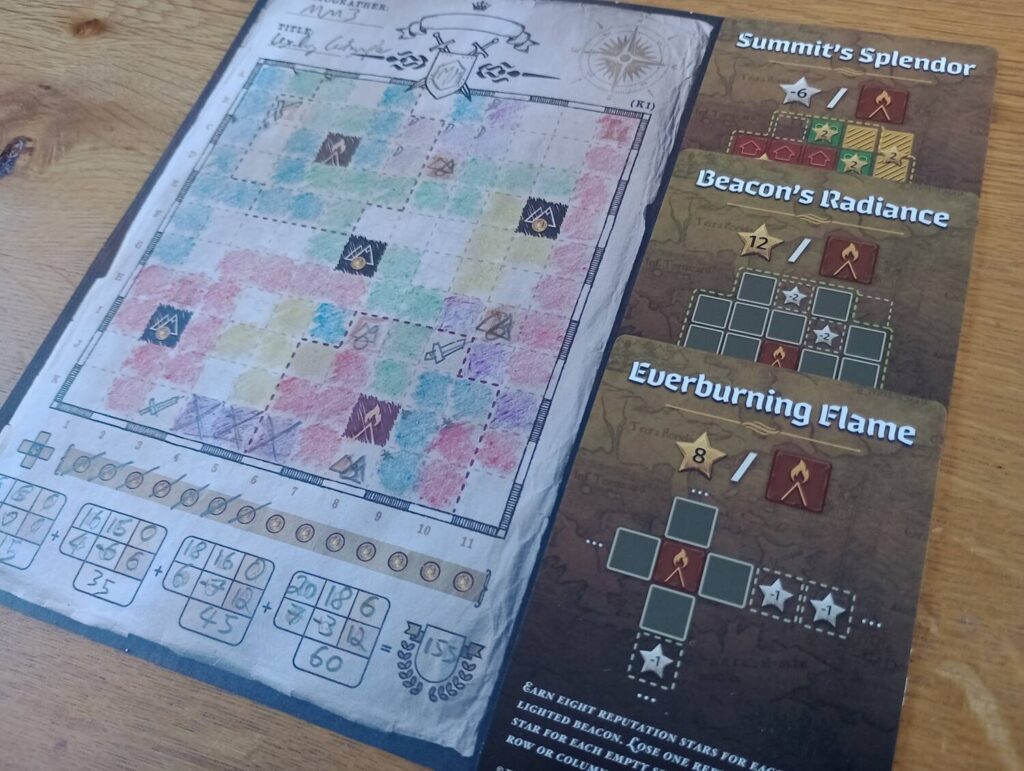
Neither Frozen Expanse nor Kethra’s Steppe fundamentally change the overall experience; each adds wrinkles to your parchment making the original task of Cartographers slightly more involved. Where Frozen Expanse showcases the constrictions of the system, forcing you to push through a hard and unforgiving landscape, Kethra’s Steppe is far more open, echoing the grassy plains of the steppe and the enticing mysteries of its two mountain-beacons. It’s a remarkable achievement, successfully incorporating distinct themes and feelings into (largely) blank maps.
Map Pack 6 – Hornhelm: Wasteland Market
Hornhelm surprised me, mostly in a good way. I’ll admit I’d assumed it was just a beefed up version of the Skills Mini Expansions (see below). Naturally, I was wrong.
A double-thick pad of paper, Hornhelm has a single map (though an awkward one, full of little canyons), a market of nine items on the other side of each sheet and six merchant cards. Each player gets a map as usual and then a second sheet with the market side up. In the three gaps between seasons you flip a merchant card and can choose to spend some of your coins on one of the three items on the market sheet which that merchant has in stock.
But, where I thought the items would allow you to bend the rules, in reality the items help you progress up a separate ‘journal’ score track which awards increasingly high amounts of points at the end of the game. All except two of the nine available items do nothing but push you up that track for doing things like drawing a shape at the edge of the map or surrounding a mountain space. And of the remaining two items, only one is actually useful in terms of gameplay, whilst the other has you destroying a square of terrain for journal points, rarely a good thing.
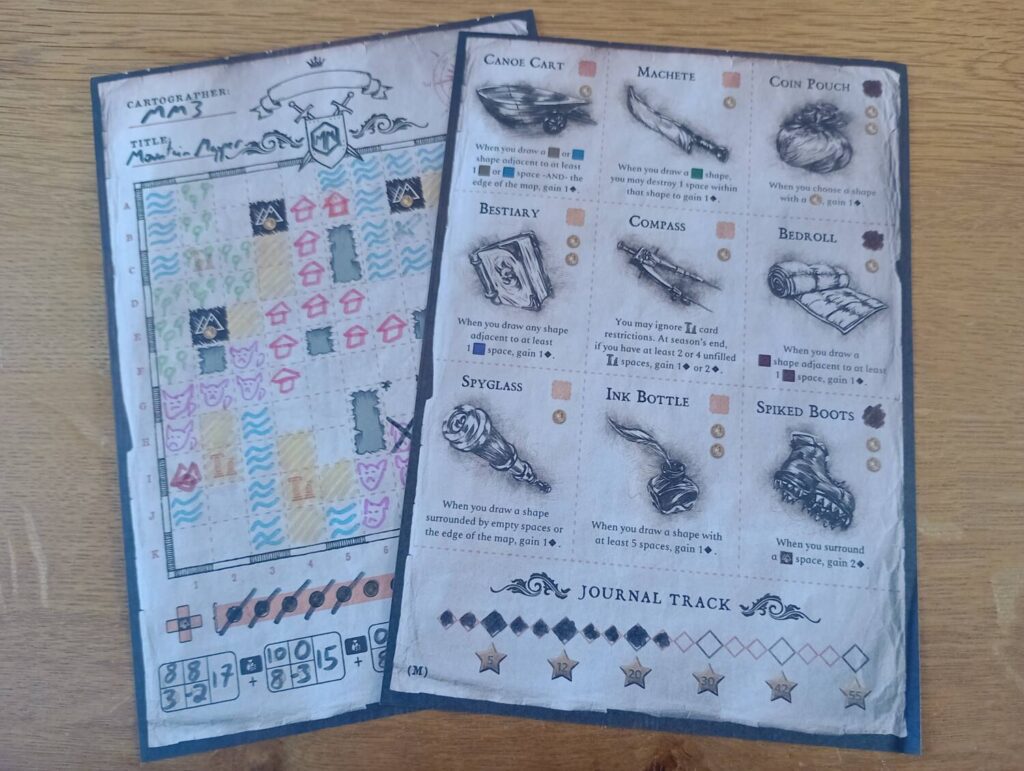
The reality is that the market and journal are meant to distract. It’s not a separate branch to win the game and if you focus on it and nothing else you’ll lose. Instead it’s a temptation to sneak a few extra points. Even the fact that the market and journal track are on a second sheet amuses, reminiscent of the ‘Distracted Boyfriend’ meme – you’re trying to maximise your points on the map whilst singing to the side is the seductive siren of the journal track. I could put this forest shape here for points from score card C, but if I put it here instead then I’ll get another two journal diamonds and cross into 20 points. In the end, far from helping you ‘map’ better, Hornhelm is no more than an additional tug on your decision process.
Which makes it a bit of a shame that many of the items reward you for doing things you’d likely be doing already: surrounding a mountain, drawing next to ambush spaces or putting the same terrain types next to each other are things you’re often trying to do anyway. The journal track just increases the incentive instead of pulling you in an additional direction.
Hornhelm is a pleasant surprise, even if the merchant’s wares could have been a little more interesting. And yes, simply progressing up a track is a board game cliché but it’s innovative enough within the Cartographers system that it works.
Skills Mini Expansions 1 & 2
The most substantial of all the Mini Expansions, the two 8-card Skills Mini Expansions can be used separately or combined into one deck for added variety. During each season you can pay precious coins to use new skills: abilities that are available in that game. These allow you to do a range of things, including duplicating shapes, adding new shapes and drawing shapes hanging off the map. Some are more situational than others but since you don’t pay for them until you need their help it’s not a problem should an opportunity not arise. It’s easy to want to use them early in the game and forget that those coins you’re spending in Spring are effectively worth four times their value in points by the end if you hang on to them.
Where Hornhelm provided a separate avenue to collect points by filling your map in often suboptimal ways, the Skills Mini Expansions give you more control over how you fill your map. For some this provides a satisfying level of control that makes the game more interesting and for others the skills feels like cheating, an over-complication of the core Cartographers experience. I personally lean slightly towards the former, but they aren’t an every game inclusion and they fall a little flat if there’s nothing interesting to do with them during a game.
Ambush Mini Expansions 1 & 2
There isn’t a lot to say about 2020’s Ambush Mini Expansion which contains four new ambush cards. Personally, I prefer ambush cards that do things in addition to taking up spaces, so 2024’s Ambush 2 Mini Expansion is much better, with some ambush cards that are quite punishing (in a fun way!). Both are inessential additions to the game but add variety if you’re playing a lot.
Champions Mini Expansion
If you like using heroes then the Champions Mini Expansion from 2022 is worth a look. It’s just four new hero patterns but it helps to keep the game fresh and a couple in particular have a decent reach in their attacks. As with the Ambush Mini Expansion, this one is inessential but a nice way to add some variety.
Architects Mini Expansion
With the release of Stonespine Architects in 2024 from Thunderworks Games comes a new mini expansion for Cartographers. Of all the four-card mini expansions this is easily the best. ‘Hortgully’ is a solid new hero teasing a coin perk, whilst ‘Slime’ is a great addition to the ambush game, splitting into smaller slimes when defeated. The new scoring card tied to spaces adjacent to mountains is an interesting challenge, I’ve enjoyed having it in circulation. Last but not least is a mountain explore card, letting you create a mountain space anywhere on your sheet. Depending on what scoring cards are available it can feel a little overpowered, particularly as it’s a free single-square addition to the explore deck, but it’s a lot of fun and provides that ‘I’ve-just-been-so-clever’ feeling that Cartographers often excels at giving players.


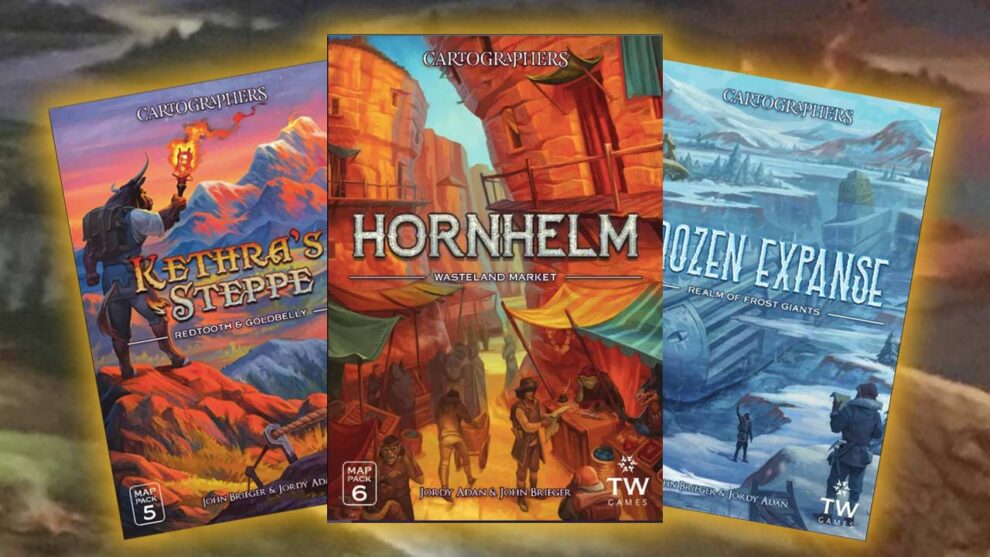




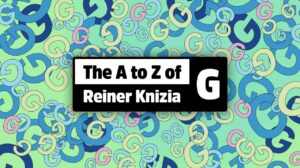

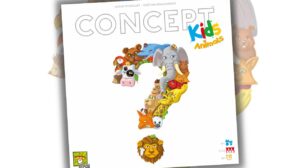





Add Comment